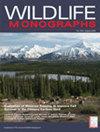狩猎对科罗拉多美洲狮种群的影响狩猎对科罗拉多美洲狮种群的影响狩猎对科罗拉多美洲狮种群的影响狩猎对科罗拉多美洲狮种群的影响
摘要
在美国科罗拉多州西南部的Uncompahgre高原(UPSA),研究了狩猎对美洲狮(puma concolor)种群的影响。我们检验了这样一个假设,即使用研究区域的独立个体的年平均采伐率为估计数量的15%,将导致独立美洲狮的丰度稳定或增加。我们预测狩猎死亡率将通过以下方式得到补偿:1)其他致死原因的减少,因此总体存活率将保持不变或增加;2)提高繁殖率;或者3)增加招募幼小动物。该研究历时10年(2004-2014),设计参照期(1-5年;即RY1-RY5),没有美洲狮狩猎和治疗期(6-10年;即TY1-TY5)与狩猎有关。我们在UPSA上捕捉并标记美洲狮,并全年监测它们的人口统计、繁殖和活动。从参考年2 (RY2)到治疗年5 (TY5),我们使用林肯-彼得森方法在科罗拉多州狩猎季节的每个冬天使用UPSA估计独立动物的丰度。此外,我们调查了猎人,以调查他们的行为如何影响收成和人口。在440个捕获事件中,我们分别在参考和治疗期间捕获并标记了110和116只独特的美洲狮。这些动物产生了75只成年、75只亚成年和118只幼崽的已知命运数据,我们用这些数据来估计性别和生命阶段特定的存活率。在参考期内,独立美洲狮的数量增加了一倍以上,并表现出较高的存活率。自然死亡是独立个体死亡的主要原因,其次是其他人为原因(例如车辆撞击、控制掠夺)。在治疗期间,猎人杀死了35只独立的美洲狮,并在UPSA捕获并释放了另外30只。经过4年的狩猎,使用UPSA的独立美洲狮的丰度下降了35%,平均每年的收获率为15%。在种群规模上,包括在UPSA上有标记的独立美洲狮、重叠的UPSA和相邻的管理单元上的收获率更高,在相同的4年里平均每年22%,导致种群数量下降。成年雌性占总收获量的21%。解释成人存活率变化的排名最高的模型()表明,周期效应与性别相互作用。参考期成年男性的年生存率(= 0.96,95% CI = 0.75-0.99)高于治疗期(= 0.40,95% CI = 0.22-0.57)。参考期成年女性的年生存率为0.86 (95% CI = 0.72-0.94),治疗期为0.74 (95% CI = 0.63-0.82)。顶部亚成虫模型显示,雌性亚成虫的存活率在参考期和治疗期保持不变(= 0.68,95% CI = 0.43 - 0.84),而雄性亚成虫的存活率与成年雄性的趋势相同,在参考期较高(= 0.92,95% CI = 0.57-0.99),在治疗期较低(= 0.43,95% CI = 0.25-0.60)。幼崽存活的最好解释是幼崽依赖时母熊的命运(母熊存活= 0.51,95% CI = 0.35-0.66;母亲死亡= 0.14,95% CI = 0.03-0.34)。独立美洲狮的年龄分布在治疗期间偏向年轻化。成年雄性受收获影响最大;经过3个狩猎季节,它们的丰度下降了59%,2个狩猎季节后,我们没有发现任何6岁的雄性。在UPSA上出生并存活到亚成虫期的美洲狮表现出亲和性和分散性。当地的招募和移民对参考期内的正增长作出了贡献,但招募并没有弥补成年男性的损失,并部分补偿了治疗期内成年女性的损失。参考组和治疗组的平均生育间隔相似(参考组= 18.3个月,95% CI = 15.5-21.1;处理期= 19.4个月,95% CI = 16.2-22.6),但产仔数(参照期= 2.8,95% CI = 2.4-3.1;治疗期= 2.4,95% CI = 2.0 ~ 2.8)和分娩率(参照期= 0.63,95% CI = 0.49 ~ 0.75;治疗期= 0.48,95% CI = 0.37-0.59)在治疗期略有下降。成功的猎人使用狗,主要选择雄性,在1-2天内收获美洲狮(中位数)。我们发现,在种群规模上,4年的年采获率平均为独立美洲狮的22%,而成年雌性占总采获量的20%,大大降低了丰度。在这个规模上,在人口下降期间,独立动物因狩猎造成的年死亡率平均比所有其他人为原因高6.3倍,比所有自然原因高4.6倍。狩猎死亡在很大程度上是累加性的,繁殖和招募并不能弥补这一死亡来源。 猎人通常选择雄性美洲狮,导致它们的存活率和丰度下降,以及种群的年龄结构。我们建议在一个源汇结构中使用规范的狩猎来保护美洲狮种群,提供可持续的狩猎机会,并解决美洲狮与人类的冲突。©2021野生动物协会。We investigated effects of regulated hunting on a puma (Puma concolor) population on the Uncompahgre Plateau (UPSA) in southwestern Colorado, USA. We examined the hypothesis that an annual harvest rate averaging 15% of the estimated number of independent individuals using the study area would result in a stable or increasing abundance of independent pumas. We predicted hunting mortality would be compensated by 1) a reduction in other causes of mortality, thus overall survival would stay the same or increase; 2) increased reproduction rates; or 3) increased recruitment of young animals. The study occurred over 10 years (2004–2014) and was designed with a reference period (years 1–5; i.e., RY1–RY5) without puma hunting and a treatment period (years 6–10; i.e., TY1–TY5) with hunting. We captured and marked pumas on the UPSA and monitored them year-round to examine their demographics, reproduction, and movements. We estimated abundance of independent animals using the UPSA each winter during the Colorado hunting season from reference year 2 (RY2) to treatment year 5 (TY5) using the Lincoln-Petersen method. In addition, we surveyed hunters to investigate how their behavior influenced harvest and the population. We captured and marked 110 and 116 unique pumas in the reference and treatment periods, respectively, during 440 total capture events. Those animals produced known-fate data for 75 adults, 75 subadults, and 118 cubs, which we used to estimate sex- and life stage-specific survival rates. In the reference period, independent pumas more than doubled in abundance and exhibited high survival. Natural mortality was the major cause of death to independent individuals, followed by other human causes (e.g., vehicle strikes, depredation control). In the treatment period, hunters killed 35 independent pumas and captured and released 30 others on the UPSA. Abundance of independent pumas using the UPSA declined 35% after 4 years of hunting with harvest rates averaging 15% annually. Harvest rates at the population scale, including marked independent pumas with home ranges exclusively on the UPSA, overlapping the UPSA, and on adjacent management units were higher, averaging 22% annually in the same 4 years leading to the population decline. Adult females comprised 21% of the total harvest. The top-ranked model explaining variation in adult survival () indicated a period effect interacting with sex. Annual adult male survival was higher in the reference period ( = 0.96, 95% CI = 0.75–0.99) than in the treatment period ( = 0.40, 95% CI = 0.22–0.57). Annual adult female survival was 0.86 (95% CI = 0.72–0.94) in the reference period and 0.74 (95% CI = 0.63–0.82) in the treatment period. The top subadult model showed that female subadult survival was constant across the reference and treatment periods ( = 0.68, 95% CI = 0.43–0.84), whereas survival of subadult males exhibited the same trend as that of adult males: higher in the reference period ( = 0.92, 95% CI = 0.57–0.99) and lower in the treatment period ( = 0.43, 95% CI = 0.25–0.60). Cub survival was best explained by fates of mothers when cubs were dependent (mother alive = 0.51, 95% CI = 0.35–0.66; mother died = 0.14, 95% CI = 0.03–0.34). The age distribution for independent pumas skewed younger in the treatment period. Adult males were most affected by harvest; their abundance declined by 59% after 3 hunting seasons and we did not detect any males >6 years old after 2 hunting seasons. Pumas born on the UPSA that survived to subadult stage exhibited both philopatry and dispersal. Local recruitment and immigration contributed to positive growth in the reference period, but recruitment did not compensate for the losses of adult males and partially compensated for losses of adult females in the treatment period. Average birth intervals were similar in the reference and treatment periods (reference period = 18.3 months, 95% CI = 15.5–21.1; treatment period = 19.4 months, 95% CI = 16.2–22.6), but litter sizes (reference period = 2.8, 95% CI = 2.4–3.1; treatment period = 2.4, 95% CI = 2.0–2.8) and parturition rates (reference period = 0.63, 95% CI = 0.49–0.75; treatment period = 0.48, 95% CI = 0.37–0.59) declined slightly in the treatment period. Successful hunters used dogs, selected primarily males, and harvested pumas in 1–2 days (median). We found that an annual harvest rate at the population scale averaging 22% of the independent pumas over 4 years and with >20% adult females in the total harvest greatly reduced abundance. At this scale, annual mortality rates of independent animals from hunting averaged 6.3 times greater than from all other human causes and 4.6 times greater than from all natural causes during the population decline. Hunting deaths were largely additive and reproduction and recruitment did not compensate for this mortality source. Hunters generally selected male pumas, resulting in a decline in their survival and abundance, and the age structure of the population. We recommend that regulated hunting in a source-sink structure be used to conserve puma populations, provide sustainable hunting opportunities, and address puma-human conflicts. © 2021 The Wildlife Society.

 求助内容:
求助内容: 应助结果提醒方式:
应助结果提醒方式:


